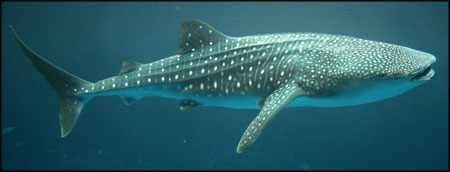
Whale Shark - the World's Largest Fish
by Grandpa Cliff 5 June 2006

![]()
A Whale Shark ( Rhincodon typus), like all other sharks, is a fish with gills. The reason that it is called a "whale" shark is because of its enormous size. Beside being the largest of the sharks, it is also the largest fish on earth, growing to a length of 50 ft (15 m) or more. By comparison, the longest Blue Whale (a marine mammal with lungs) has been recorded at 108 feet.
The Whale Shark is covered with many white or yellow spots, and it is solid white or yellow on the bottom. It has several ridges along each side of its body, the largest of which reaches the tail fin [caudal fin]. Because of its size, you might expect that a Whale Shark would be a ferocious predator, but it is is not. Instead of the large teeth we expect to find in the mouth of a shark, it has about 300 rows of tiny teeth in each jaw. The shark has a gentle nature and can be approached by divers who need not fear for their safety.
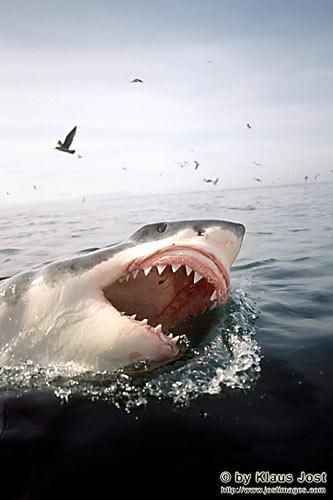
The Great White Shark (right) and almost all other sharks have their
mouth on the bottom of their head. The Whale Shark is the only large shark which has it at the front (below).
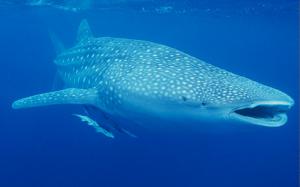
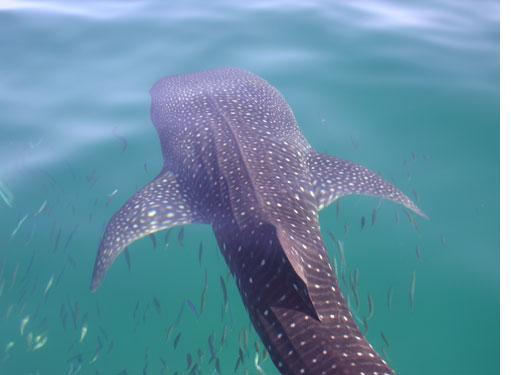
Great WhiteShark [S]
This is a real photo of a live shark
living free in the sea.
The tip of the head of the Whale Shark is straight across (see left) rather than pointed like that of the Great White Shark.
Two pectoral fins join the body just behind the head.
Surprisingly, this shark's primary food is tiny plants and animals (plankton),
food that is usually no
larger than ¼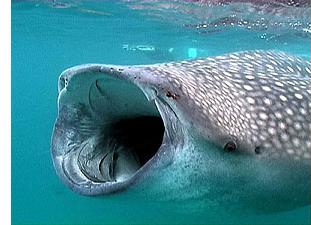 inch. However, its mouth is mammoth and it can swim
through a school of fish or plankton and capture many of them. As its mouth is
opened, much water flows in to fill it. That inflowing water can carry
many members of the school inside. A fish might be two or three feet away,
but it can't overcome the strong current of water flowing into the shark's
mouth.
inch. However, its mouth is mammoth and it can swim
through a school of fish or plankton and capture many of them. As its mouth is
opened, much water flows in to fill it. That inflowing water can carry
many members of the school inside. A fish might be two or three feet away,
but it can't overcome the strong current of water flowing into the shark's
mouth.
Watch tropical fish feed on food that is sinking or that is on the bottom. You will see that the food moves towards the fish when they open their mouths.
[Notice the lack of large teeth in this gaping mouth.] [S]
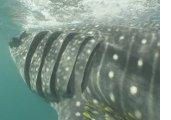 On
each side of the head of the
Whale Shark are five gill slits (just in front of the pectoral fins). The water
passes over the gills before leaving the mouth through the
gill slits. The gills allow fish to extract needed oxygen from the sea water that is
taken in through the mouth. A part of each gill acts as a filter to prevent the tiny
plankton
from passing out through the gill slits as well. Whale Sharks are
sometimes referred to as filter feeders, because the gills filter the tiny food
out of the water.
On
each side of the head of the
Whale Shark are five gill slits (just in front of the pectoral fins). The water
passes over the gills before leaving the mouth through the
gill slits. The gills allow fish to extract needed oxygen from the sea water that is
taken in through the mouth. A part of each gill acts as a filter to prevent the tiny
plankton
from passing out through the gill slits as well. Whale Sharks are
sometimes referred to as filter feeders, because the gills filter the tiny food
out of the water.
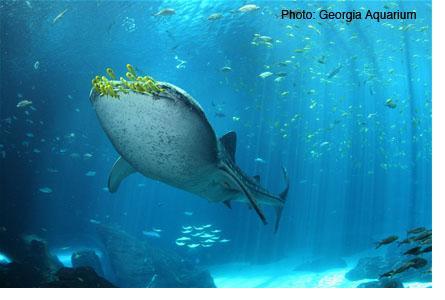 In
June 2006, two immature female Whale Sharks were aquired by the Georgia Aquarium.
They were added to a tank already holding two male Whale Sharks. The tank
is about the size of a football field (the largest aquarium in the world).
On television, it showed the Whale Sharks slowly swimming past the camera, often with a
group of yellow fish in front of their mouths.
In
June 2006, two immature female Whale Sharks were aquired by the Georgia Aquarium.
They were added to a tank already holding two male Whale Sharks. The tank
is about the size of a football field (the largest aquarium in the world).
On television, it showed the Whale Sharks slowly swimming past the camera, often with a
group of yellow fish in front of their mouths.

These small yellow fish at the Georgia Aquarium are the Golden Trevally (close-up at right). What are they doing by the shark's mouth? Are they playing? Do you think the little fish are living dangerously?
When a large object passes through water, most of the water passes around it, but some of the water is pushed ahead. The water pushed ahead is called a bow wave (pronounced like now). A small fish can get into the bow wave and be pushed along without much effort of their own. According to a person at the Georgia Aquarium with whom I spoke, they ride there for protection from being eaten by other fish which stay clear of this large shark. The Whale Shark does not eat them.
Note: I have a goldfish that finds that the bow wave sometimes makes it difficult for it to get its food. I feed the fish small pellets which I drop by hand, one at a time. The pellets float for about 5-10 seconds. When the goldfish sees my fingers approaching the surface of the water, it comes to the surface and waits for me to drop the pellet. When I do, the goldfish approaches the pellet to swallow it, but what happens is that the pellet is pushed away from the goldfish by the bow wave. It makes 2-3 short lunges at the pellet, but can't get it until it starts to sink. If I drop the pellet before the goldfish reaches the surface, it comes up from below the floating pellet and has no trouble getting it into its mouth that way.
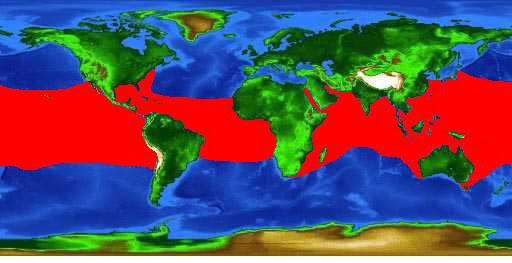
Worldwide Distribution of the Whale Shark (in red)
The Whale Shark generally lives in tropical seas, but in the western Atlantic Ocean it can be found as far north as New York. That is because the Gulf Stream ocean current carries warm tropical water northward along the east coast of the United States, thus allowing the Whale Shark to live in that area farther north than would be expected.
|
Classification of the WHALE SHARK
Phylum - Chordata Subphylum - Vertebrata Class - Chondrichthyes |
![]()
![]()
Grandpa Cliff's Science Website for Teenagers (HOME)
Visitors since 30
Dec 2006